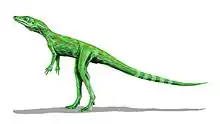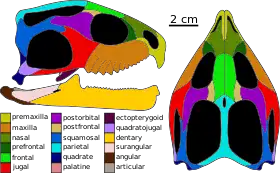| Quebrada del Barro Formation | |
|---|---|
| Stratigraphic range: Norian | |
| Type | Geological formation |
| Unit of | Marayes Group |
| Underlies | Los Riscos Formation |
| Overlies | Carrizal Formation |
| Lithology | |
| Primary | Sandstone |
| Other | Siltstone |
| Location | |
| Coordinates | 31°54′S 67°12′W / 31.9°S 67.2°W |
| Approximate paleocoordinates | 40°48′S 30°00′W / 40.8°S 30.0°W |
| Region | San Juan Province |
| Country | |
| Extent | Marayes-El Carrizal Basin |
 Quebrada del Barro Formation (Argentina) | |
The Quebrada del Barro Formation is a geological formation of the Marayes-El Carrizal Basin in San Juan Province, Argentina. This formation is the most fossiliferous portion of the Triassic Marayes Group, and is also the youngest unit of the group, overlying the El Carrizal Formation. An unconformity at the top of the Quebrada del Barro Formation separates it from the Cretaceous-age Los Riscos Formation of the El Gigante Group.[1][2][3][4] Part of the formation may be made into a provincial park following the discovery of the fossils of Ingentia, a giant sauropodomorph dinosaur which helped elucidate the early evolution of sauropods.[5]
Sedimentology
The Quebrada del Barro Formation formed within a rift basin during a period of renewed fracturing. It encompasses 600 to 1,400 metres (2,000 to 4,600 ft) of red sandstones, fine conglomerates, and diamictites.[3] Early hypotheses on the depositional environment proposed that the sediments formed in an alluvial fan or braided river system, while a newer proposal outlines how four different facies within the formation can be used to reconstruct a meandering semiarid floodplain deposited by mudflows and discharging in heterolithic terminal splays.[6]
Fossil content
The fauna of Quebrada del Barro is similar to that of the neighboring Los Colorados Formation which is considered to be from the Norian stage of the Late Triassic.[7] Both formations preserve fossils from groups such as sauropodomorph dinosaurs, cynodonts, and testudinatans. However, Quebrada del Barro is more abundant in sphenodontians (Sphenotitan), tritheledontid cynodonts, and coelophysoid dinosaurs (Lucianovenator), while sauropodomorphs are somewhat less common and aetosaurs are completely absent, in contrast to the Los Colorados Formation.[3] Sphenodontians and cynodonts are also abundant in microfossil assemblages.[6] In addition, the Quebrada del Barro Formation preserves some of the only pterosaur and Dromomeron specimens known from Triassic strata in Argentina. Although the sphenodontian and cynodont-dominated fauna of Quebrada del Barro is akin to that of the Faxinal del Sotorno assemblage of the Brazilian Caturrita Formation, the fauna of the Faxinal del Sotorno assemblage is otherwise indicative of an older part of the Triassic than the Quebrada del Barro Formation.[3]
Dinosaurs
| Theropods of the Quebrada del Barro Formation | ||||||
|---|---|---|---|---|---|---|
| Genus | Species | Material | Notes | Images | ||
| Lucianovenator[8] | L. bonoi | Several specimens including vertebrae, hip fragments, and a partial tibia | A coelophysid theropod | |||
| Sauropodomorphs of the Quebrada del Barro Formation | ||||||
|---|---|---|---|---|---|---|
| Taxon | Species | Material | Notes | Images | ||
|
I. prima |
"cervical and dorsal vertebrae, scapula" |
|||||
| Leyesaurus[2] | L. marayensis | A massospondylid sauropodomorph. Known from uppermost layers which may belong to a different unit of Hettangian (Early Jurassic) age.[3] |  | |||
| Sauropodomorpha | sp. | Complete foot and tail vertebrae | Undiagnostic sauropodomorph remains originally referred to Riojasaurus[2][10] | |||
Other avemetatarsalians
| Non-dinosaur avemetatarsalias of the Quebrada del Barro Formation | ||||||
|---|---|---|---|---|---|---|
| Taxon | Species | Material | Notes | Images | ||
| Dromomeron[11] | D. gigas | A partial femur | a lagerpetid |  | ||
| Pachagnathus | P. benitoi | Snout fragment | A raeticodactylid pterosaur[12] | |||
| Pterosauria | sp. | Partial ulna | an indeterminate pterosaur[3] | |||
| Yelaphomte | Y. praderioi | Snout fragment | A raeticodactylid pterosaur[12] | |||
Pseudosuchians
| Pseudosuchias of the Quebrada del Barro Formation | ||||||
|---|---|---|---|---|---|---|
| Taxon | Species | Material | Notes | Images | ||
| "Rauisuchidae" | sp. | Skull fragments, osteoderms | an indeterminate "rauisuchid" smaller than Fasolasuchus[3] | |||
| Crocodylomorpha | sp. | A specimen including a partial osteoderm and vertebrae fragments | Indeterminate, possibly a "sphenosuchid"[3] | |||
| Crocodylomorpha | sp. | Two incomplete specimens including osteoderms, vertebrae, and other bones | a protosuchid, possibly synonymous with Hemiprotosuchus[3] | |||
Rhynchocephalians
| Rhynchocephalians of the Quebrada del Barro Formation | ||||||
|---|---|---|---|---|---|---|
| Genus | Species | Material | Notes | Images | ||
| Sphenotitan[13] | S. leyesi | numerous specimens (~50% of all recovered fossils)[3] | an eilenodontine sphenodontian |  | ||
Other reptiles
| Other reptiles of the Quebrada del Barro Formation | ||||||
|---|---|---|---|---|---|---|
| Taxon | Species | Material | Notes | Images | ||
| Archosauriformes | sp. | Maxilla, caudal vertebra, metatarsal, indeterminate limb bone (tibia?) | Various indeterminate fragments likely belonging to pseudosuchians or dinosauromorphs[4] | |||
| Waluchelys | W. cavitesta | 2 partial skeletons and carapaces | an australochelyid stem-turtle[14][3] | |||
Synapsids
| Synapsids of the Quebrada del Barro Formation | ||||||
|---|---|---|---|---|---|---|
| Taxon | Species | Material | Notes | Images | ||
| Tritheledontidae | sp. | 36 specimens, including a partial skeleton | an undescribed tritheledontid cynodont. May be two taxa based on two morphotypes: "long-snout" and "short-snout".[3] | |||
References
- ↑ Gardini et al., 2009, p.554
- 1 2 3 Cecilia Apaldetti; Ricardo N. Martinez; Oscar A. Alcober; Diego Pol (2011). Claessens, Leon (ed.). "A New Basal Sauropodomorph (Dinosauria: Saurischia) from Quebrada del Barro Formation (Marayes-El Carrizal Basin), Northwestern Argentina". PLOS ONE. 6 (11): e26964. doi:10.1371/journal.pone.0026964. PMC 3212523. PMID 22096511.
- 1 2 3 4 5 6 7 8 9 10 11 12 Martínez, Ricardo N.; Apaldetti, Cecilia; Correa, Gustavo; Colombi, Carina E.; Fernández, Eliana; Malnis, Paula Santi; Praderio, Angel; Abelín, Diego; Benegas, Laura G.; Aguilar-Cameo, Andrea; Alcober, Oscar A. (August 2015). "A New Late Triassic Vertebrate Assemblage from Northwestern Argentina". Ameghiniana. 52 (4): 379–390. doi:10.5710/AMGH.27.04.2015.2889. hdl:11336/111650. ISSN 0002-7014. S2CID 131662341.
- 1 2 Gianechini, Federico A.; Codorniú, Laura; Arcucci, Andrea B.; Castillo Elías, Gabriela; Rivarola, David (March 2016). "Archosauriform remains from the Late Triassic of San Luis province, Argentina, Quebrada del Barro Formation, Marayes–El Carrizal Basin". Journal of South American Earth Sciences. 66: 110–124. doi:10.1016/j.jsames.2015.12.012. ISSN 0895-9811.
- ↑ "Uac wants a provincial park in the cradle of Ingenia Prima". Naaju. Retrieved 2018-07-15.
- 1 2 Colombi, Carina E.; Martínez, Ricardo N.; Correa, Gustavo; Fernández, Eliana; Malnis, Paula Santi; Praderio, Angel; Apaldetti, Cecilia; Abelín, Diego; Alcober, Oscar; Aguilar-Cameo, Andrea (October 2015). "First Argentine Microfossil Bonebed from the Upper Triassic Marayes—El Carrizal Basin, San Juan Province". PALAIOS. 30 (10): 743–757. doi:10.2110/palo.2014.055. hdl:11336/4899. ISSN 0883-1351. S2CID 131239254.
- ↑ Weishampel, David B; et al. (2004). "Dinosaur distribution (Late Triassic, South America)." In: Weishampel, David B.; Dodson, Peter; and Osmólska, Halszka (eds.): The Dinosauria, 2nd, Berkeley: University of California Press. Pp. 527–528. ISBN 0-520-24209-2.
- ↑ Ricardo N. Martínez; Cecilia Apaldetti (2017). "A late Norian-Rhaetian coelophysid neotheropod (Dinosauria, Saurischia) from the Quebrada del Barro Formation, northwestern Argentina". Ameghiniana. in press. doi:10.5710/AMGH.09.04.2017.3065.
- ↑ Apaldetti; Martínez, Ricardo N.; Cerda, Ignatio A.; Pol, Diego; Alcober, Oscar (2018). "An early trend towards gigantism in Triassic sauropodomorph dinosaurs". Nature Ecology & Evolution. 2 (8): 1227–1232. doi:10.1038/s41559-018-0599-y. hdl:11336/89332. PMID 29988169. S2CID 49669597.
- ↑ "Riojasaurus." In: Dodson, Peter & Britt, Brooks & Carpenter, Kenneth & Forster, Catherine A. & Gillette, David D. & Norell, Mark A. & Olshevsky, George & Parrish, J. Michael & Weishampel, David B. The Age of Dinosaurs. Publications International, LTD. p. 41. ISBN 0-7853-0443-6.
- ↑ Ricardo N. Martínez; Cecilia Apaldetti; Gustavo A. Correa; Diego Abelín (2016). "A Norian lagerpetid dinosauromorph from the Quebrada del Barro Formation, northwestern Argentina". Ameghiniana. 53 (1): 1–13. doi:10.5710/AMGH.21.06.2015.2894. S2CID 131613066.
- 1 2 Martínez, Ricardo N.; Andres, Brian; Apaldetti, Cecilia; Cerda, Ignacio A. (March 2022). "The dawn of the flying reptiles: first Triassic record in the southern hemisphere". Papers in Palaeontology. 8 (2). doi:10.1002/spp2.1424. ISSN 2056-2799. S2CID 247494547.
- ↑ Martinez, R. N.; Apaldetti, C.; Colombi, C. E.; Praderio, A.; Fernandez, E.; Malnis, P. S.; Correa, G. A.; Abelin, D.; Alcober, O. (2013). "A new sphenodontian (Lepidosauria: Rhynchocephalia) from the Late Triassic of Argentina and the early origin of the herbivore opisthodontians". Proceedings of the Royal Society B: Biological Sciences. 280 (1772): 20132057. doi:10.1098/rspb.2013.2057. PMC 3813332. PMID 24132307.
- ↑ Sterli, Juliana; Martínez, Ricardo N.; Cerda, Ignacio A.; Apaldetti, Cecilia (2021). "Appearances can be deceptive: bizarre shell microanatomy and histology in a new Triassic turtle (Testudinata) from Argentina at the dawn of turtles". Papers in Palaeontology. 7 (2): 1097–1132. doi:10.1002/spp2.1334. ISSN 2056-2802. S2CID 225515560.
Bibliography
- Gardini, Carlos; Rivarola, David; Agüera, Maximiliano; Candela, Gerónimo (2009). "Estructura de la región Sierra de Guayaguas-Marayes, Provincias de San Juan y San Luis" (PDF). Revista de la Asociación Geológica Argentina. 65: 551–565. Retrieved 2018-09-08.